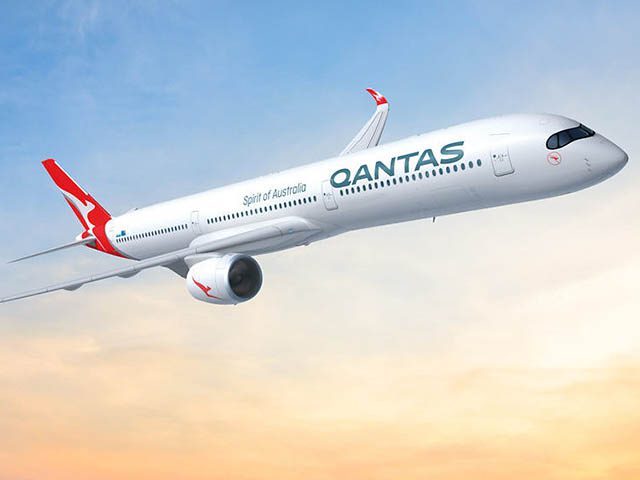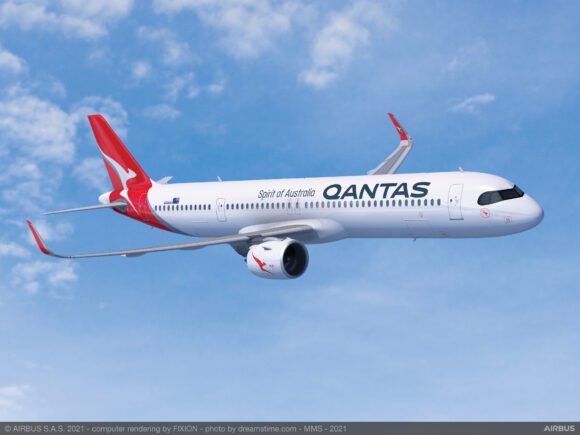
Qantas A350 1000©Airbus
Qantas is to confirm its long-expected order for the Airbus A350-1000 as part of its Project Sunrise project on May 2. The airline will also finalize the in-principle agreement for the A220 and A321XLR it announced in December. Qantas has scheduled a press event early on Monday morning local time in Sydney. Qantas set to confirm Project Sunrise and narrowbody orders.
Airbus will spice up the event, having dispatched an airBaltic A220-300 to Sydney. After departing Riga on April 28, the aircraft made a stop-over in Delhi, flew on to Denpasar (Indonesia) on the 29th, and arrived in Sydney on the evening of April 30. On Saturday, A350-1000 test aircraft MSN059 departed Toulouse for a non-stop flight to Perth. From there, the aircraft will continue to Sydney. The aircraft features “LongRangeLeader” and Qantas decals.
In February, Qantas said at its HY1 results presentation that it wanted to restart Project Sunrise, subject to Board approval. Two months on, and the project is on track again. The airline is expected to confirm an order for twelve A350-1000s, having chosen the type in December 2019 as the preferred aircraft for ultra-long-range flights over the offering from Boeing of the 777X. This likely will have been the 777-8, although the type wasn’t officially launched back then and hasn’t been since. On the contrary, the development of the -8 was mothballed earlier in 2019 and with first deliveries of the 777-9 further delayed this week until 2025 and the 777-8F the next version to be developed, there was no way Boeing could have met Qantas’ Project Sunrise schedule of 2025. Which is already a year later than originally planned.
It will be interesting to see what Airbus has to say about the special features of what is supposed to become a sub-version of the A350-1000. The airframer said earlier that the aircraft wouldn’t be an ultra-long-range (ULR) version as such, as compared to the A350-900ULR that is used by Singapore Airlines. The -900ULR has a range of 9.700 nautical miles/18.000 kilometers, thanks to a higher fuel capacity (48.500 kilograms) and a modified fuel system. According to Airbus specifications, the -900ULR ideally comes with a 173-seat two-class cabin arrangement, but Singapore Airlines’ ULR has only 161 seats: 67 Business and 94 Premium Economy. The standard A350-900 comes with 332 seats in a three-class arrangement or 440 in a single-class version. The forward cargo hold is de-activated on the -900ULR.
Expect a seat number of around 200
If this is any indication of what to expect from the version selected by Qantas, the longer A350-1000 should see between twenty and forty extra seats over the -900ULR, or around 200 in total. This compares to 372 seats for the standard -1000 with a three-class cabin. The lower seat count is the price that is paid for meeting the range capability to do Melbourne/Sydney to London or New York nonstop. Also, passengers want to travel in more comfort and space when they are on a twenty-hour flight. Three Project Sunrise-route proving flights on the Boeing 787-9 in 2019 with just forty passengers on board confirmed the importance of space and the ability of passengers to move around, do physical exercises, and relax to stay physically and mentally fit.
Another interesting detail: how do the numbers add up to justify the business case of Project Sunrise? CEO Alan Joyce said this in December 2019 during one of the 787-9 test flights: “We’ll only commit to this investment if we know it will generate the right return for our shareholders given the inherent commercial risks.” With soaring fuel prices, much higher than in 2019, tickets are expected to become significantly more expensive compared to what Qantas must have included in the original business case. Are passengers willing to pay (so much) extra for a time benefit from a nonstop flight? Will the airline still make a profit?
Qantas said it plans to order twenty A321XLRs plus options. (Airbus)
Narrowbody order
As far as the narrowbody order is concerned, unless Qantas has revised the numbers, this should be a simple confirmation of twenty A220-300s and twenty A321XLRs, plus 94 purchase rights. The order is part of Project Winton, for which Qantas compared the A220-300 with the Embraer E2-series and the A321XLR with the Boeing MAX. That subsidiary Jetstar has eighteen A321LRs on order was one factor that tilted the balance in favor of the XLR. Getting “a material discount on list prices” is another one, as Qantas confirmed in December. But whereas Jetstar selected the CFM LEAP for its order, Qantas has already confirmed its choice for the Pratt & Whitney Geared Turbofan. From a fleet commonality point of view between Jetstar and Qantas, this seems an odd choice. But remember that the A220s come with GTFs only and there will be cost efficiencies here, not to forget a discount.
These new aircraft orders plus more 787-9s coming in have covered Qantas’ fleet plans for some time. Ten out of twelve A380s are brought back into service to operate on the high-density, long-haul routes to the US, Asia, and Europe. This leaves the A330 as the next model that will need replacement on the domestic and medium-haul network, as the -200s and -300s are now fourteen and almost eighteen years old respectively.
Views: 11




